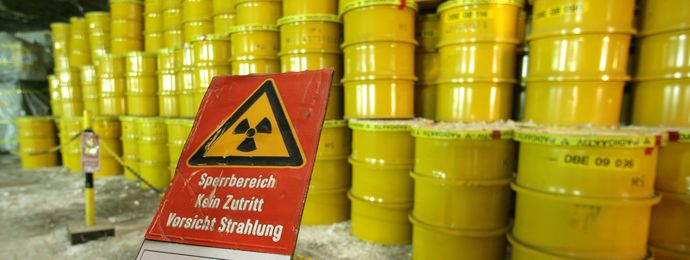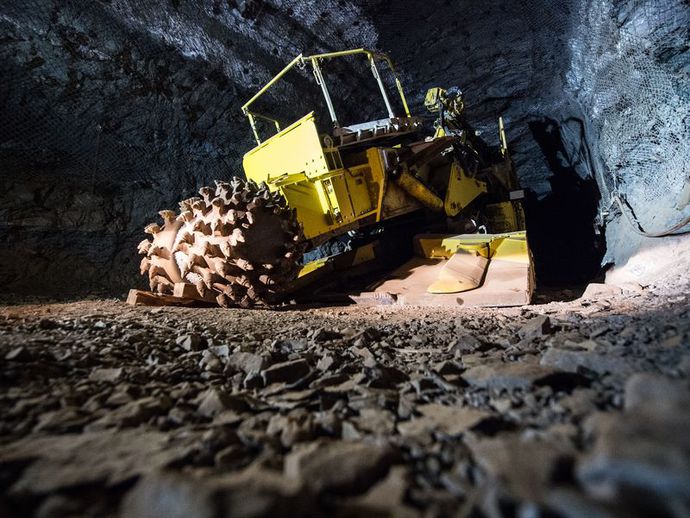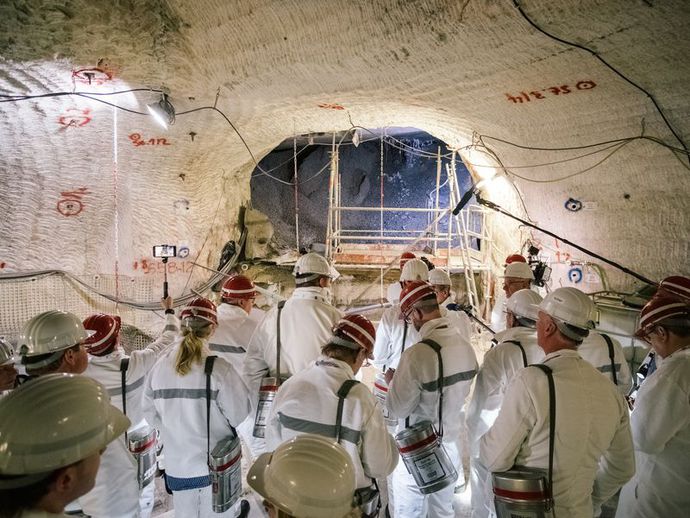-
BASE
subnavigation
BASE
- About us
- Laboratorium
- Career
- Laws and regulations
- Legal Basis
- Manual on Reactor Safety and Radiation Protection
- 1A Nuclear and radiation protection law
- 1B Other laws
- 1C Transport law
- 1D Bilateral agreements
- 1E Multilateral agreements
- 1F EU law
- 2 General administrative provisions
- 3 Announcements of the BMU and the formerly competent BMI
- 4 Relevant provisions and recommendations
- 5 Nuclear Safety Standards Commission (KTA)
- 6 Key committees
- Annex to the NS Handbook
- A 1 English translations of laws and regulations
- Dose coefficients to calculate radiation exposure
- BASE topics in the Bundestag
-
Topics
subnavigation
Topics
Supervision
- Overview Supervision
- Supervision site selection
- Nuclear Supervisory Authority
- Mining Supervision
Nuclear Safety
Interim Storage / Transport
-
News
subnavigation
BASE: Federal Nuclear Supervisory Authority
The Federal Office for the Safety of Nuclear Waste Management (Bundesamt für die Sicherheit der Nuklearen Entsorgung, formerly Bundesamt für kerntechnische Entsorgungssicherheit (BfE)) is the federal government's nuclear supervisory authority. It was founded in 2016. BASE is responsible for supervising the construction, operation and decommissioning of
- the Morsleben radioactive waste repository (ERAM),
- the Konrad repository (under construction), and
- the Asse II mine.
BASE will also exercise nuclear supervision over the construction and operation of the future repository for high-level radioactive waste.
These duties are based on the Atomic Energy Act (AtG), the Radiation Protection Act (StrlSchG), the Radiation Protection Ordinance (StrlSchV), the licences and planning approval decisions issued for the licensing of repositories, and other nuclear regulations.
Morsleben, Konrad and Asse II repositories
The Bundesgesellschaft für Endlagerung (BGE) mbH has been the operator of the Morsleben and Konrad repositories and the Asse II mine since 2017. It is in charge of building, operating and/or decommissioning the Morsleben and Konrad repositories as well as the Asse II mine.
Every ten years, BGE mbH will conduct a safety review at the Konrad repository and the Asse II mine, the one at the Morsleben repository will take place once every five years. BASE will accompany these reviews as the nuclear supervisory authority.
Profile: Morsleben, Konrad and Asse II
BASE is the nuclear supervisory authority for the Morsleben and Konrad repositories and the ASSE II mine. BGE mbH is the operator. Further facts on the type of rock, the current status and a brief history of the three repositories for low- and intermediate-level radioactive waste can be found below:
Morsleben Repository (Morsleben Repository for Radioactive Waste/ERAM) show / hide
Type of rock: Salt
Location: Saxony-Anhalt
Status: open
Goal: Decommissioning or backfilling with salt concrete (duration: approx. 15-20 years)
Operator: BGE mbH
Nuclear regulatory authority: BASE
Licensing authority: Ministry of Science, Energy, Climate Protection and the Environment of Saxony-Anhalt.
Facts and figures
The former potash and rock salt mine of the former GDR is being converted into a repository for low- and medium-level radioactive waste:
- 1971: Waste is stored on a trial basis
- 1978-1981: Trial operation
- 1981: Five-year operating licence
- 1986: Permanent operating licence (valid until today)
- 1989: The Federal Office for Radiation Protection (BfS) becomes operator
- 1994-1998: Storage of low- and intermediate-level radioactive waste
- 2001: Site is reassessed. Result: BfS no longer stores waste.
- There are 36,752 m³ of radioactive waste in the Morsleben repository, about 60 per cent of which was emplaced after 1990.
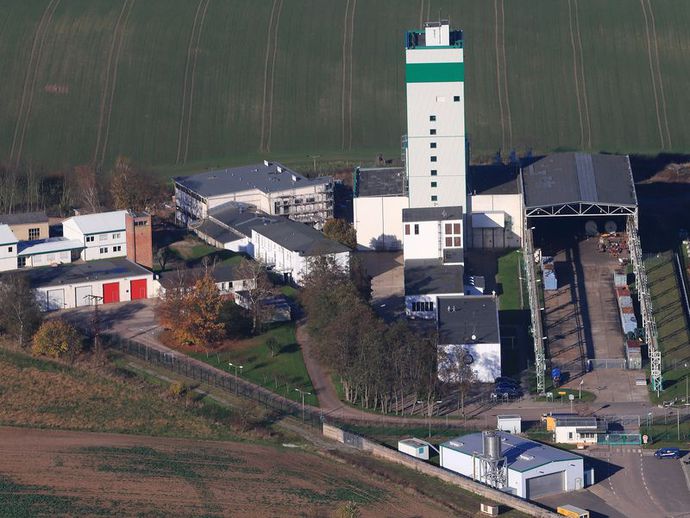
![]() Morsleben repository for low and intermediate level nuclear waste
Source: pa/ ZB | Jens Wolf
Morsleben repository for low and intermediate level nuclear waste
Source: pa/ ZB | Jens Wolf
Information on the Morsleben repository on the Internet
Konrad repositoryshow / hide
Rock type: Iron ore
Location: Lower Saxony
Status: expected to be built by 2027 (for max. 303,000 m³ of radioactive waste)
Operator: BGE mbH
Nuclear regulatory supervision: BASE
Licensing authority until commissioning: Lower Saxony Ministry for the Environment, Energy and Climate Protection
Licensing authority after commissioning: BASE
Facts and figures
- 1965-1976: Iron ore mine: Konrad 1 shaft and Konrad 2 shaft
- 1976 -1982: A review shows that the Konrad mine offers good conditions for a repository for low- and intermediate-level radioactive waste.
- 1982: Start of the nuclear planning approval procedure for the construction of a repository.
- 2002: Planning approval decision
- 2007: The Federal Ministry for the Environment, Nature Conservation and Nuclear Safety (BMU) commissions the then operator, the Federal Office for Radiation Protection (BfS), to build the Konrad repository.
- Konrad is the first repository in Germany to be planned and approved under nuclear law.
- 2027: expected commissioning

![]() Future transport route for low- and intermediate-level waste to the Konrad mine repository.
Source: pa/ ZUMAPRESS.com | Jannis Grosse
Future transport route for low- and intermediate-level waste to the Konrad mine repository.
Source: pa/ ZUMAPRESS.com | Jannis Grosse
Information on the Konrad repository on the Internet
Asse II shaft show / hide
Rock type: Salt
Location: Lower Saxony
Status: Waste is retrieved, mine will then be decommissioned.
Operator: BGE mbH
Nuclear regulatory authority: BASE
Licensing authority: Lower Saxony Ministry for the Environment, Energy and Climate Protection
Facts and figures:
- 1967-1978: Storage of approx. 126,000 barrels (47,000 m³) of low- to intermediate-level radioactive waste. The operator of the mine was the Gesellschaft für Strahlenforschung (today: Helmholtz Zentrum München; HMGU).
- From 1971: Asse II serves as a repository for low- and intermediate-level radioactive waste from all over Germany.
- 1979-1997: Research work on the final disposal of high-level radioactive waste in salt
- 1997: The federal government decides to close the Asse II mine in accordance with mining law. The original plan was to fill the mine with solids.
- 2009: The Federal Office for Radiation Protection (BfS) assumes role of operator. Mining law and nuclear law have applied to the Asse II mine since then.
- 2013: Decision: The waste is to be retrieved. This is enshrined in the Atomic Energy Act.
- BGE mbH has been operator of the mine since 2017.
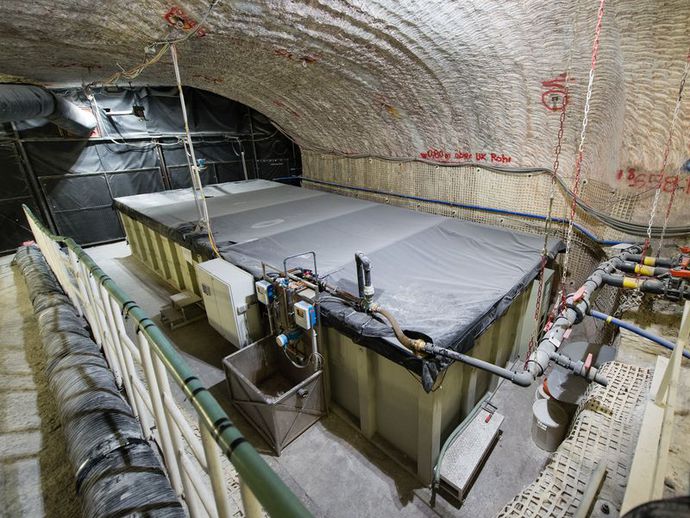
![]() Central water catchment basin in the Asse II mine
Source: pa/ dpa | Sebastian Gollnow
Central water catchment basin in the Asse II mine
Source: pa/ dpa | Sebastian Gollnow
Information on the Asse mine on the Internet
Duties of the nuclear supervisory authority
As the nuclear regulator, BASE has the following specific duties and powers:
Informs about reportable events at the plantsshow / hide
BASE is responsible for providing public information about incidents, accidents or other events relevant to nuclear safety at the Morsleben repository, Konrad and the Asse II mine. BGE mbH is obliged to report such events to BASE. All since 2017 are published on the BASE website.
The reporting criteria in the Nuclear Safety Officer and Reporting Ordinance form the basis for this. There are three reporting categories : Category S - Immediate report (without delay), Category E - Urgent report (within 24 hours), Category N - Normal report (within 5 working days).
Consents to the appointment of persons in charge in accordance with nuclear lawshow / hide
The operator appoints one or more persons in accordance with nuclear law. These persons shall be responsible for ensuring compliance with the obligations arising from the Atomic Energy Act, the Radiation Protection Ordinance and the licensing documents.
BASE approves the appointment of persons in charge according to nuclear law (Sections 9b para. 4, 7 para. 2 no. 1 AtG). The person responsible under nuclear law is the first point of contact for BASE on all questions relating to repository safety and compliance with the obligations arising from the licensing documents or legal provisions.
Furthermore, the person in charge according to the Federal Mining Act is another contact point for BASE regarding final disposal in mines.
Carries out examinations and measurements to monitor the environmentshow / hide
BASE is in charge of monitoring the surroundings of the Morsleben repository and the Asse II mine. It has commissioned independent metrology bodies to do this.
- For the Morsleben repository, this is currently the Saxony-Anhalt State Office for Environmental Protection (LAU).
- For the Asse II mine, this is currently the "IAF - Radioökologie GmbH".
The measurements cover the radioactive substances released from a repository to the environment via waste water and sewage. The air, precipitation, surface water, drinking water, groundwater and soil in the vicinity of a repository, but also the vegetation, the rural food chain such as crops and meat products as well as milk and dairy products are also sampled metrologically.
As the operator, BGE mbH regularly takes samples of air, water, soil, vegetation, fruit, vegetables and milk, and compare its measurement results with those of BGE mbH. It assesses the radiation exposure as well as compliance with the maximum permissible activity discharges. The maximum permissible activity data and dose limits must be complied with. This is based on the Guideline for Emission and Immission Monitoring of Nuclear Facilities (REI).
In addition to the legally required measurements, an additional measurement programme in the interest of the citizens and local agriculture took place near the Asse II mine until 2017.
BASE will publish the measurement results it has commissioned:
Environmental monitoring reports
Issues clearances for waste to be disposed of outside the plantshow / hide
BASE issues clearance certificates (Section 31 StrlSchV): Radioactive materials and movable objects, buildings and ground surfaces that could be activated or contaminated may not exceed certain clearance values so as to be disposed of as waste.
The clearance values can be found in the Radiation Protection Ordinance. Clearance measurements are frequently carried out, especially in the Asse II mine. This is necessary because the water running from the surrounding rock into the salt dome is being removed on a continuing basis.
Implements modification proceduresshow / hide
So-called modification procedures will be implemented in case of changes to the way facilities are built or operated. Changes that do not deviate significantly from the approved planning will be examined and subsequently approved by BASE.
An application must be submitted to the licensing authority for any major modification. In the case of the Konrad repository and the Asse II mine, the competent authority would be the Lower Saxony Ministry for the Environment, Energy and Climate Protection.
In the case of the Morsleben repository, it would be the Ministry for the Environment, Agriculture and Energy of Saxony-Anhalt.
Carries out pre-inspections show / hide
BASE carries out inspections of the repositories, and makes sure that construction work complies with the permits and legal regulations (e.g. planning approval decisions). In addition, BASE inspects the facilities, systems, components and facility safety.
BASE will also carry out an overall inspection once every five years for the Morsleben repository, and once every ten years for the Konrad repository and the Asse II mine.
Gives instructions in case of imminent dangershow / hide
BASE may issue instructions to initiate protective measures or to temporarily cease operation (Section 19 para 3 of the Atomic Energy Act). This will occur,
- if the facilities do not meet the requirements of nuclear and radiation protection law, or
- if there is a risk that radioactivity will have negative consequences for life, health or property.
Checks the reliability of persons in chargeshow / hide
BASE must verify the reliability of all persons relevant to the safety of the repositories and the Asse II mine (Section 12b AtG; AtZüV (Atomrechtliche Zuverlässigkeitsüberprüfungsverordnung (Nuclear reliability review ordinance)). This includes, for example, an identity check, an enquiry with the police and the Office for the Protection of the Constitution, an enquiry with the Federal Commissioner for Stasi Records and with the Central Register of Foreigners/Aliens Authority. Depending on the activity and responsibility of the persons to be examined, BASE will carry out correspondingly extensive checks. Such an examination will only be carried out if the persons have given their prior written consent.
Status talks between BASE and BGE
Within the framework of these supervisory activities, supervisory status talks at management level are held between BASE and BGE mbH at regular intervals. The minutes of these status talks are available for viewing.
Minutes of the supervisory status talksshow / hide
You will find the minutes of the status talks that have so far taken place between BASE and BGE mbH here. They contain all the discussion points on the repository projects that have arisen in the course of the supervisory activities.
Note: The agenda items from the supervisory status talks that concern the repository search can be found on the central repository search Infoplattform zur Endlagersuche.
(Minutes on various talks only in German)
Protokoll: 1. Statusgespräch am 13.12.2017 (PDF, 60 KB, accessible)
Protokoll: 2. Statusgespräch am 21.03.2018 (PDF, 61 KB, accessible)
Protokoll: 3. Statusgespräch am 21.01.2019 (PDF, 131 KB, accessible)
Protokoll: 4. Statusgespräch am 06.05.2019 (PDF, 66 KB, accessible)
Protokoll: 5. Statusgespräch am 28.11.2019 (PDF, 124 KB, accessible)
Protokoll: 6. Statusgespräch am 24.06.2020 (PDF, 67 KB, accessible)
Protokoll: 7. Statusgespräch am 07.12.2020 (PDF, 68 KB, accessible)
Looking back: re-organisation of final disposal and founding of BASE
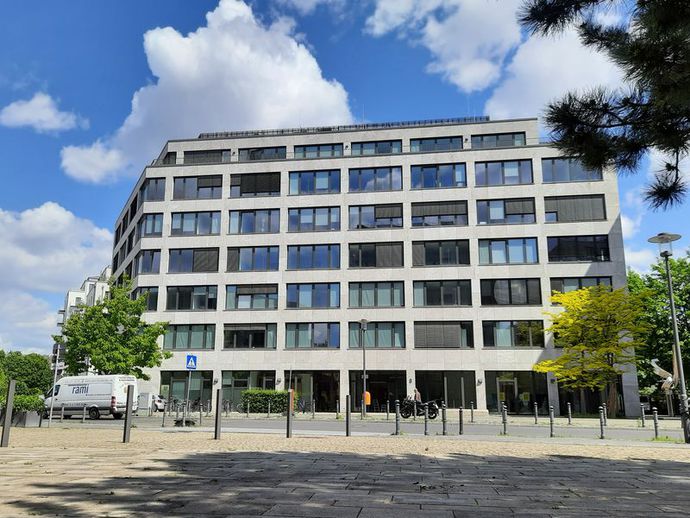
![]() BASE headquarters building at Wegelystraße 8 in Berlin
Source: BASE
BASE headquarters building at Wegelystraße 8 in Berlin
Source: BASE
Allocation of duties before the re-organisation
The Federal Office for Radiation Protection (BfS) was the operator of the Konrad, Morsleben and Asse II repository projects, as well as the Gorleben exploration mine, until April 2017.
The BfS was bound to the "Deutsche Gesellschaft zum Bau und Betrieb von Endlagern mbH" (DBE mbH) by a non-terminable cooperation agreement (1989). Said company had taken over the operational activities for the Konrad and Morsleben repository projects and the Gorleben exploration mine.
DBE mbH was a privately-owned company, with the nuclear power plants as the major owners. The BfS therefore had only limited influence on the operational business. For: DBE mbH had tried to assert its own interests against the BfS by misusing its monopoly position.
With regard to the Asse II mine, the BfS founded a new federal company, Asse GmbH, which took over operations in 2009. Considerable violations of radiation protection law by the former operator, Helmholtz Zentrum München, had become known prior to this.
2016: Bundestag decides to re-organise final disposal
The German Bundestag passed a law to re-organise the organisational structure in the field of final disposal in summer 2016. All tasks were transferred to the state. This law was based on recommendations from Wolfram König, then President of the Federal Office for Radiation Protection (BfS), who headed BASE from 2016 to January 2024.
The aim of the re-organisation was to create more transparency in the organisational structure, and to disentangle economic and security interests.
Founding of BGE mbH and BASE
The law led to the establishment of the Bundesgesellschaft für Endlagerung mbH (BGE mbH) - a federally owned company that emerged from DBE mbH, Asse GmbH and parts of BfS. BGE mbH has been the operator since 2017, and at the same time responsible for the operational business of the Morsleben and Konrad repositories and the Asse II mine, as well as for the closure of the former Gorleben exploration mine.
Since then, supervision under nuclear law has been the responsibility of the Federal Office for the Safety of Nuclear Waste Management (BASE, formerly BfE), which was also newly founded. BASE also emerged from parts of the BfS.
State of 2024.01.31

